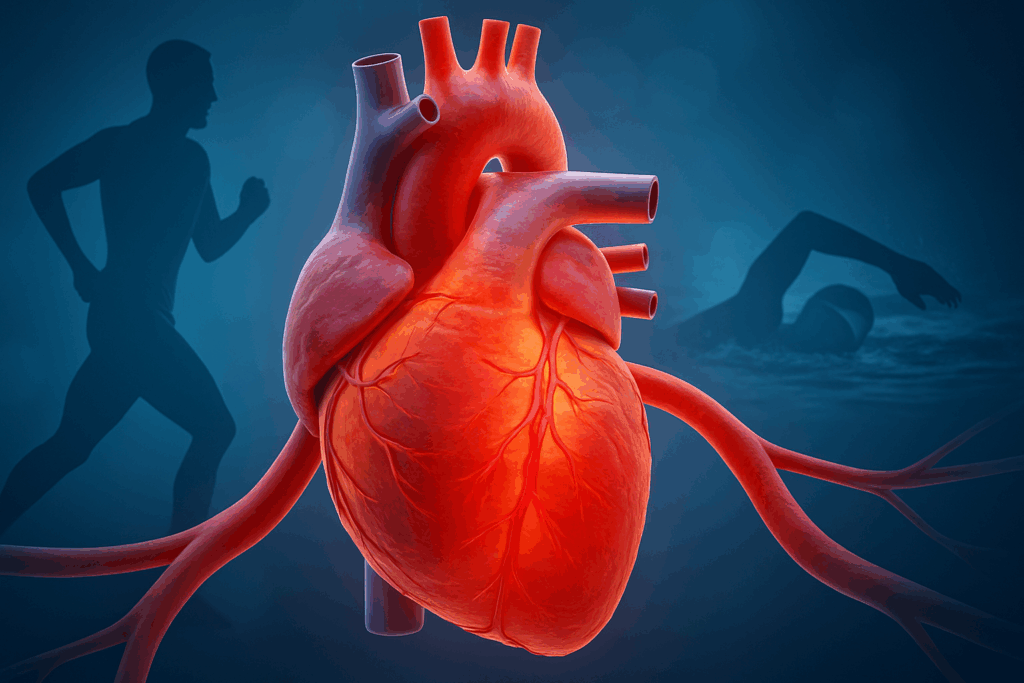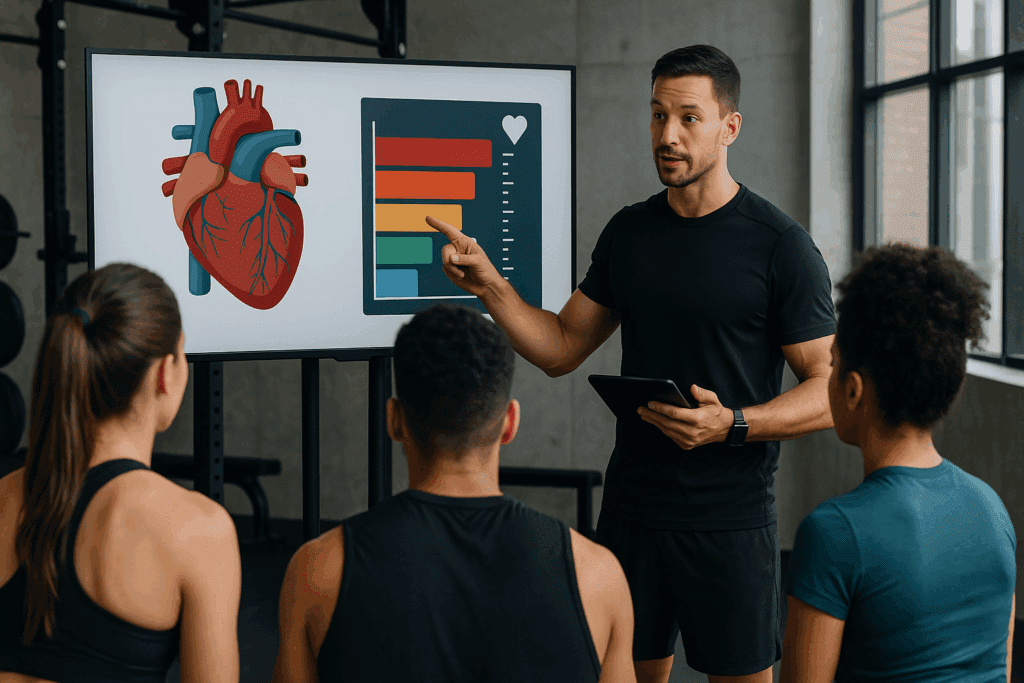Endurance and cardiovascular strength have long stood as pillars of athletic excellence, not only for elite athletes but also for anyone pursuing a healthier, more resilient lifestyle. While performance training often centers on metrics such as VO2 max, lactate threshold, or muscle output, the importance of cardiovascular wellness is frequently underappreciated. In recent years, healthy heart education has emerged as a transformative component in performance training—bridging the gap between heart health awareness and practical application in athletic and recreational fitness routines. For athletes, weekend warriors, and even sedentary individuals beginning a fitness journey, understanding the role of the heart is essential. Without a healthy cardiovascular system, endurance training can plateau, risks of sudden cardiac events may increase, and long-term performance outcomes may falter.
In this comprehensive guide, we will explore how heart health education is redefining performance training, empowering individuals with the knowledge to sustain stamina, prevent cardiovascular issues, and ultimately push their physical boundaries safely. This intersection of preventive cardiology, exercise physiology, and behavior change reveals that the heart is not merely a metaphorical engine for endurance—it is the literal centerpiece.
You may also like: Smart Nutrition Choices for a Healthier Lifestyle: What to Know About Whole Grain Rice and Whole Wheat Rice

The Crucial Link Between Cardiovascular Health and Endurance Performance
To understand the significance of healthy heart education in performance training, one must begin with the physiological role of the heart in endurance activity. The heart is responsible for pumping oxygen-rich blood to the muscles, facilitating aerobic respiration, which is essential for sustained movement. During cardiovascular exercise, cardiac output increases significantly, ensuring that tissues receive the oxygen and nutrients needed to perform efficiently.
A stronger heart can pump more blood with each beat—a concept known as stroke volume—which translates to a lower resting heart rate and more efficient oxygen delivery during exertion. Athletes with well-trained cardiovascular systems often exhibit a lower heart rate at submaximal intensities and recover more rapidly after intense bouts. These adaptations reduce fatigue and improve performance longevity. Thus, educating individuals on how training impacts heart structure and function is foundational to effective endurance development.
Moreover, heart health education helps individuals distinguish between healthy cardiovascular adaptation and warning signs of distress. Conditions such as arrhythmias, hypertension, or myocarditis can present subtly and may be exacerbated by intense training. Learning how to monitor symptoms, interpret heart rate variability, and seek timely medical evaluation can mean the difference between optimized training and catastrophic events. This knowledge creates informed athletes who can train smarter—not just harder.

What Healthy Heart Education Teaches Athletes and Fitness Enthusiasts
At its core, healthy heart education aims to empower individuals with evidence-based knowledge about cardiovascular function, disease prevention, and optimal performance strategies. It extends beyond general awareness and into applied learning, where understanding cardiac output, heart rate zones, and recovery metrics becomes integral to an effective training regimen.
One key area of emphasis is aerobic base building. Many athletes focus disproportionately on high-intensity workouts, believing that pushing harder always leads to better results. However, training in specific heart rate zones—especially the moderate-intensity aerobic zone—builds foundational endurance while minimizing the risk of overtraining. Heart health education emphasizes the long-term cardiovascular benefits of zone 2 training, where fat is utilized efficiently for energy, mitochondrial density improves, and the heart becomes stronger without excessive strain.
In addition, individuals learn how lifestyle factors such as nutrition, hydration, sleep, and stress management affect heart function. For instance, electrolyte imbalances from poor hydration can increase cardiac arrhythmia risk during endurance activities. Sleep deprivation compromises recovery and elevates resting heart rate, impeding performance gains. By incorporating this knowledge into daily habits, athletes can create a holistic framework that sustains both performance and heart health.
Heart Health Education as a Preventive Tool in Athletic Communities
Prevention is a cornerstone of modern cardiovascular care, and performance training environments are no exception. Healthy heart education serves as a vital preventive tool, particularly in communities where individuals push physical limits. High school and collegiate athletes, for instance, may undergo intense conditioning without sufficient understanding of cardiac risk factors, predisposing them to sudden cardiac arrest—a rare but tragic event.
Educational programs that include basic heart screenings, recognition of red-flag symptoms, and guidelines for returning to play after illness can significantly reduce these risks. Understanding conditions such as hypertrophic cardiomyopathy or congenital arrhythmias—and how they interact with physical exertion—can inform training decisions and save lives. Furthermore, community access to automated external defibrillators (AEDs) and training on their use should be a routine extension of heart health education.
Such education also normalizes cardiovascular self-monitoring. Wearable technology now provides real-time data on heart rate, heart rate variability, and even electrocardiogram (ECG) readings. Healthy heart education enables users to interpret this data responsibly, distinguishing between normal training responses and abnormalities that warrant attention. With informed interpretation, these tools transform from fitness gadgets into lifesaving devices.

Fueling Performance: Nutrition’s Role in Cardiovascular and Endurance Health
A critical but often overlooked component of endurance training is the heart’s relationship with nutrition. The foods athletes consume directly affect vascular function, lipid profiles, and inflammatory status—all of which influence endurance and cardiovascular resilience. Educating individuals on how to optimize their diets for heart health is therefore paramount.
Diets rich in omega-3 fatty acids, antioxidants, complex carbohydrates, and lean proteins support vascular integrity and reduce oxidative stress, enhancing endurance. Conversely, high intake of trans fats, excessive sodium, and added sugars can impair endothelial function and increase arterial stiffness—compromising both heart health and stamina. Through healthy heart education, individuals can learn to interpret food labels, make strategic meal choices, and time their nutrient intake around training sessions to support both performance and cardiovascular function.
Moreover, specific micronutrients such as magnesium, potassium, and B vitamins play direct roles in cardiac conduction and muscle metabolism. Deficiencies can lead to cramping, fatigue, or even arrhythmias during prolonged exercise. Educating athletes on how to meet their nutritional needs through whole foods rather than supplements alone promotes sustainable performance gains while protecting the heart from avoidable strain.

Using Training Zones and Biofeedback for Smarter Conditioning
Training according to heart rate zones is a fundamental principle that many fitness enthusiasts overlook. While pace or perceived exertion are useful, heart rate offers a quantifiable and individualized measure of intensity. Healthy heart education introduces athletes to the concept of five primary training zones, ranging from recovery to maximum effort, and how each zone elicits different physiological adaptations.
For example, training in zone 2—approximately 60-70% of maximum heart rate—stimulates aerobic capacity without inducing excessive stress. In contrast, zone 4 training (approximately 80-90% of max heart rate) targets anaerobic threshold, improving the body’s ability to buffer lactic acid. Alternating between these zones strategically over time helps develop endurance, power, and recovery efficiency.

Biofeedback tools such as heart rate monitors, recovery trackers, and ECG-based wearables can enhance this process by offering real-time insight into how the heart is responding. When athletes understand this feedback through healthy heart education, they can adjust intensity levels, avoid overtraining, and identify recovery needs with precision. This not only optimizes performance but also supports long-term cardiovascular health.

Mental Resilience, Stress, and Their Impact on Cardiovascular Endurance
Endurance training is not only a physical challenge—it is a mental one. Psychological stress activates the sympathetic nervous system, increasing heart rate and blood pressure. Chronic stress can elevate cortisol levels, contribute to systemic inflammation, and impair sleep quality, all of which affect cardiovascular health and endurance capacity. Through healthy heart education, individuals can begin to understand the complex interplay between emotional well-being and heart performance.
Meditation, deep breathing, and mindfulness-based stress reduction techniques are now widely accepted tools in both sports psychology and cardiology. Athletes who integrate these practices not only experience better recovery and mood stabilization but also improve heart rate variability—a key marker of cardiovascular adaptability. Educating athletes and fitness enthusiasts on how to recognize the signs of chronic stress and employ practical, heart-supportive coping mechanisms is essential for performance longevity.
Moreover, building mental resilience through positive self-talk, goal-setting, and visualization techniques can reduce anxiety before competitions and prevent burnout. When combined with physiological insights from heart rate tracking, these strategies create a feedback loop where both mind and body inform performance adaptations. A truly comprehensive approach to endurance training must consider this psychosomatic connection.

Recovery, Resting Heart Rate, and Overtraining Syndrome
Recovery is where training adaptations truly take root, and the heart plays a central role in signaling readiness for the next session. A low resting heart rate is often seen as a marker of fitness, but sudden deviations—especially increases—may indicate incomplete recovery or the onset of overtraining syndrome. Heart health education teaches individuals how to track resting heart rate trends over time and interpret changes contextually.
Overtraining syndrome is a condition marked by persistent fatigue, declining performance, disrupted sleep, mood changes, and elevated resting heart rate. Recognizing these signs early allows athletes to modify training loads, incorporate active recovery, and prevent long-term damage. Without this knowledge, individuals may push through warning signs, leading to injury, illness, or cardiovascular strain.
Additionally, healthy heart education emphasizes the importance of sleep hygiene, hydration, and parasympathetic nervous system activation—through activities like yoga or massage—for enhancing cardiac recovery. These restorative practices help reestablish autonomic balance, improving not only heart rate variability but also emotional well-being and motivation to train.
Lifelong Benefits of Integrating Heart Health Education into Training Culture
The long-term benefits of integrating healthy heart education into athletic culture extend well beyond immediate performance outcomes. Athletes who develop cardiovascular literacy are better equipped to maintain health through all stages of life. Former competitors who transition into coaching, physical education, or general fitness instruction can pass on this knowledge, creating ripple effects across communities.
Moreover, individuals who understand the tenets of heart health are more likely to engage in preventive behaviors such as routine screenings, cholesterol management, and hypertension control. This knowledge also demystifies heart disease, allowing earlier recognition of symptoms and more effective interventions. As endurance athletes age, the principles learned through heart health education continue to serve them, mitigating age-related decline in cardiovascular function.
In an era where cardiovascular disease remains the leading cause of death globally, embedding preventive heart education into sports and fitness culture is a public health imperative. It empowers individuals to take ownership of their heart health from a place of knowledge rather than fear, transforming endurance training from a short-term pursuit into a sustainable, health-supporting practice.
Frequently Asked Questions: Boost Endurance and Protect Your Heart
1. How does healthy heart education impact the mental game of endurance athletes?
Healthy heart education contributes significantly to mental resilience in endurance sports by teaching athletes how to interpret and respond to cardiovascular signals like heart rate variability and resting heart rate changes. When athletes understand these metrics, they gain greater confidence in their training plans and recovery strategies, reducing anxiety before competition. This clarity can improve emotional regulation during races and support mental endurance. Furthermore, understanding the relationship between emotional stress and cardiac performance allows athletes to implement stress-reduction techniques—such as mindfulness or breathing exercises—at moments when mental fatigue might otherwise impair cardiovascular function. Ultimately, healthy heart education empowers endurance athletes to treat psychological health as part of physical conditioning.
2. Can heart health education influence training decisions in youth sports?
Yes, and its influence can be life-saving. When introduced early, heart health education teaches young athletes to recognize signs of cardiovascular distress, like dizziness or irregular heartbeat, which might otherwise be ignored. Coaches and athletic programs that incorporate this knowledge can make informed decisions about intensity levels, rest days, and referral to medical professionals when needed. With the rise in youth participation in high-stress sports, understanding how cardiovascular systems develop through adolescence is crucial. Proactive use of healthy heart education in school and community programs helps establish a culture of safety, prevention, and long-term athletic sustainability.
3. What role does healthy heart education play in managing endurance setbacks after illness or injury?
Recovering from illness or injury—especially when it involves the cardiovascular system—requires a nuanced understanding of how to reintroduce exercise safely. Heart health education equips athletes with tools to monitor signs of cardiac overload, such as unusually high heart rates at low intensities or prolonged recovery times. Athletes returning from COVID-19, for example, may experience myocarditis or lingering heart symptoms that need careful management. A well-informed approach helps prevent complications and allows gradual rebuilding of endurance based on real-time data rather than assumptions. Healthy heart education enables athletes to treat the recovery process as a strategic phase, not a setback.
4. How do cultural and socioeconomic factors influence access to heart health education?
Access to heart health education is often shaped by systemic disparities. In lower-income or rural areas, there may be limited availability of cardiology screenings, sports medicine professionals, or educational materials tailored for non-specialist audiences. Cultural stigmas around heart disease or physical vulnerability can also limit proactive discussions, especially in communities that valorize toughness over caution. Addressing these gaps requires inclusive, community-based healthy heart education initiatives that respect local values while promoting evidence-based care. Mobile health units, telehealth education, and bilingual outreach materials can help extend life-saving knowledge to underserved populations.
5. How is wearable technology reshaping the future of healthy heart education?
Wearable devices have dramatically changed how we engage with cardiovascular data, making heart health education more interactive and personalized. Athletes can now track heart rate variability, ECG readings, and recovery scores with consumer-grade devices. But the value of this data depends on proper interpretation—something that healthy heart education provides. With growing AI integration, future tools may not only monitor the heart but also offer real-time coaching based on personal trends and thresholds. Healthy heart education is essential for transforming raw data into meaningful action, helping athletes avoid both overtraining and complacency.
6. How can healthy heart education support female endurance athletes specifically?
Female athletes face unique cardiovascular dynamics due to hormonal fluctuations, especially related to menstrual cycles, pregnancy, and menopause. These changes can impact blood pressure regulation, heart rate variability, and even susceptibility to arrhythmias. Unfortunately, most performance training protocols have historically been developed with male physiology in mind. Healthy heart education tailored to women’s health can bridge this knowledge gap by incorporating research-backed guidelines on training intensity, hydration needs, and cardiac risk profiles specific to females. This approach promotes equity in sports medicine and ensures that performance strategies align with the physiological realities of female endurance athletes.
7. What are the long-term benefits of incorporating heart health education into workplace wellness programs?
While often overlooked, workplace wellness programs are an ideal platform for promoting heart health education to the general population, including amateur athletes. Long-term exposure to healthy heart education in the workplace fosters a culture of cardiovascular awareness that can reduce sick days, enhance productivity, and even improve morale. Providing resources like biometric screenings, fitness challenges, and heart-rate-based group training sessions can create behavior change that persists beyond office hours. Over time, employees develop habits that support endurance, such as regular aerobic activity and stress management techniques, contributing to both personal and organizational health.
8. How does heart health education contribute to reducing gender disparities in cardiovascular research and awareness?
Historically, cardiovascular research has been disproportionately focused on male subjects, leading to a gap in diagnosis and treatment for women. By raising awareness of these disparities, heart health education prompts both individuals and institutions to advocate for more inclusive research and diagnostic protocols. Educational campaigns that spotlight symptoms of heart disease specific to women—such as jaw pain, shortness of breath, or fatigue—help close this knowledge gap. In turn, healthy heart education promotes better-informed training strategies, earlier detection of problems, and more equitable health outcomes. This fosters an environment where endurance training can thrive across genders.
9. What practical steps can recreational athletes take to personalize their heart health education?
Personalizing heart health education begins with understanding your unique cardiovascular profile through tools like resting heart rate tracking, stress testing, and metabolic assessments. Recreational athletes can use this data to tailor endurance routines, ensuring training aligns with personal heart rate zones and recovery capacity. Consulting with a sports cardiologist or an exercise physiologist can help interpret this data within the context of long-term health goals. Joining heart health-focused fitness communities, subscribing to educational newsletters, and attending workshops are additional ways to build customized knowledge. The more individualized your healthy heart education is, the more sustainable and effective your endurance training will be.
10. How might future developments in heart health education intersect with genetics and precision medicine?
As genetic testing becomes more accessible, future models of heart health education may incorporate individual risk factors for cardiovascular disease and exercise intolerance. Genetic insights can identify predispositions to conditions like atrial fibrillation, high blood pressure, or hypertrophic cardiomyopathy. By integrating these findings into training plans, athletes can adopt preventive strategies well before symptoms arise. Precision medicine also supports nutrient timing, recovery optimization, and stress management protocols based on genetic profiles. Healthy heart education that evolves alongside these advancements will enable athletes to engage in truly personalized endurance performance strategies rooted in the latest scientific understanding.
Conclusion: Elevating Performance Through the Power of Healthy Heart Education
In the landscape of modern fitness and athletic development, healthy heart education is more than a supplemental concept—it is a foundational element. By bridging the gap between exercise science and preventive cardiology, this form of education equips individuals with the tools to elevate performance while protecting long-term health. Through a deep understanding of cardiovascular physiology, training zone application, nutritional strategy, stress regulation, and recovery practices, athletes at all levels can train with greater intelligence and impact.
When heart health education is integrated into performance training, the results extend far beyond the track or gym. They touch every aspect of wellness, fostering resilience, stamina, and a lifelong commitment to health. As we continue to advance in our understanding of the human body and its capabilities, let us not overlook the heart—both as a biological organ and a symbol of strength. To boost endurance effectively, we must educate, empower, and protect the very engine that drives human performance.
Was this article helpful? Don’t let it stop with you. Share it right now with someone who needs to see it—whether it’s a friend, a colleague, or your whole network. And if staying ahead on this topic matters to you, subscribe to this publication for the most up-to-date information. You’ll get the latest insights delivered straight to you—no searching, no missing out.
Further Reading:
Physical Activity and Your Heart
Exploring the Limits of Exercise While Protecting Heart Health

